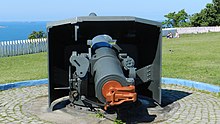This article explains terms used for the British Armed Forces' ordnance (weapons) and ammunition. The terms may have slightly different meanings in the military of other countries.

The BL 8-inch howitzer Mark I through to Mark V were a British improvisation developed early in the First World War to provide heavy artillery. It used shortened and bored-out barrels from various redundant naval 6-inch guns.

The BL 6-inch gun Mark VII was a British naval gun dating from 1899, which was mounted on a heavy travelling carriage in 1915 for British Army service to become one of the main heavy field guns in the First World War, and also served as one of the main coast defence guns throughout the British Empire until the 1950s.
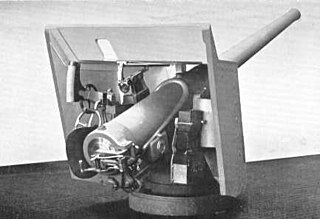
The QF 4.7-inch Gun Mks I, II, III, and IV were a family of British quick-firing 4.724-inch (120 mm) naval and coast defence guns of the late 1880s and 1890s that served with the navies of various countries. They were also mounted on various wheeled carriages to provide the British Army with a long range gun. They all had a barrel of 40 calibres length.

The Ordnance BL 15-pounder, otherwise known as the 15-pounder 7 cwt, was the British Army's field gun in the Second Boer War and some remained in limited use in minor theatres of World War I. It fired a shell of 3-inch diameter with a maximum weight of 15 pounds (6.8 kg), hence its name which differentiated it from its predecessor '12-pounder' 3-inch gun which fired shells weighing only 12.5 pounds (5.7 kg).

The QF 6-inch 40 calibre naval gun (Quick-Firing) was used by many United Kingdom-built warships around the end of the 19th century and the start of the 20th century.

The Ordnance QF Hotchkiss 6 pounder gun Mk I and Mk II or QF 6 pounder 8 cwt were a family of long-lived light 57 mm naval guns introduced in 1885 to defend against new, small and fast vessels such as torpedo boats and later submarines. There were many variants produced, often under license which ranged in length from 40 to 58 calibers, but 40 caliber was the most common version.
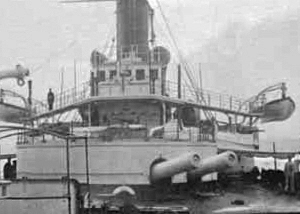
The BL 12 inch naval gun Mk I was a British rifled breech-loading naval gun of the early 1880s intended for the largest warships such as battleships and also coastal defence. It was Britain's first attempt to match the large guns being installed in rival European navies, particularly France, after Britain transitioned from rifled muzzle-loading guns to the modern rifled breech-loaders somewhat later than the European powers. Mks I - VII all had a barrel of approximately 303 inches in length and similar performance.
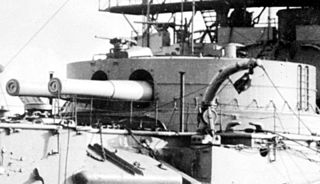
The BL 13.5 inch naval gun Mk I was Britain's first successful large breechloading naval gun, initially designed in the early 1880s and eventually deployed in the late 1880s. Mks I - IV were all of 30 calibres length and of similar construction and performance.
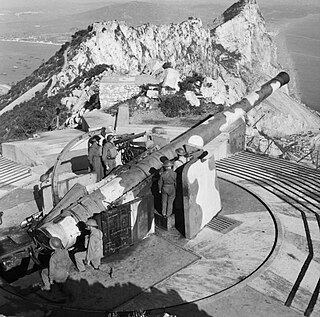
The BL 9.2-inch Mk IX and Mk X guns were British breech loading 9.2-inch (234 mm) guns of 46.7 calibre, in service from 1899 to the 1950s as naval and coast defence guns. They had possibly the longest, most varied and successful service history of any British heavy ordnance.
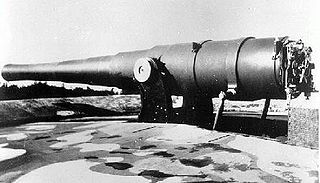
The BL 9.2-inch Mk I–VII guns were a family of early British heavy breechloading naval and coast defence guns in service from 1881 to the end of World War I. They were originally designed to use the old gunpowder propellants.
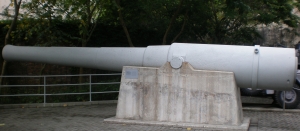
The BL 10 inch guns Mks I, II, III, IV were British rifled breechloading 32-calibre naval and coast defence guns in service from 1885.

The QF 4-inch gun Mks I, II, III were early British QF (quick-firing) naval guns originating in 1895. They all had barrels of 40 calibres length.

The BL 8 inch guns Mark I to Mark VII were the first generations of British rifled breechloaders of medium-heavy calibre. They were initially designed for gunpowder propellants and were of both 25.5 and 30 calibres lengths.
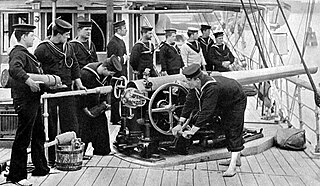
The BL 4-inch gun Mk I – Mk VI were a family of early British breech-loading 4-inch naval guns.

The BL 4-inch Mark VIII naval gun was a British medium-velocity wire-wound naval gun introduced in 1908 as an anti-torpedo boat gun in smaller ships whose decks could not support the strain of the heavier and more powerful Mk VII gun.

The BL 5-inch guns Mk I – Mk V were early British 5-inch rifled breechloading naval guns after it switched from rifled muzzle-loaders in the late 1870s. They were originally designed to use the old gunpowder propellants. The 5-inch calibre was soon discontinued in favour of QF 4.7-inch.

The BL 7.5-inch Mk II–Mk V guns were a variety of 50-calibre naval guns used by Britain in World War I. They all had similar performance and fired the same shells.

The BL 6-inch 80-pounder gun Mk I was the first generation of British 6-inch breechloading naval gun after it switched from muzzle-loaders in 1880. They were originally designed to use the old gunpowder propellants.



